Vacuum Arc Remelting (VAR) - ALD Vacuum Technologies
Vacuum Arc Remelting (VAR) - ALD Vacuum Technologies
Vacuum Arc Remelting (VAR) - ALD Vacuum Technologies
You also want an ePaper? Increase the reach of your titles
YUMPU automatically turns print PDFs into web optimized ePapers that Google loves.
Directional Solidification<br />
of the <strong>Vacuum</strong> <strong>Arc</strong><br />
<strong>Remelting</strong> Process<br />
Precise control of the local<br />
solidification rate of the<br />
temperature gradient at the<br />
liquid/solid interface<br />
Achieving the optimum <strong>VAR</strong> ingot<br />
solidification structure requires precise<br />
control of the local solidification rate<br />
and the temperature gradient at the<br />
liquid/solid interface.<br />
High Temperature Gradient<br />
at the solidification front must be maintained during<br />
the entire remelting process to achieve a directed<br />
dendritic primary structure.<br />
Dendrite Growth Direction<br />
conforms to the direction of the temperature gradient,<br />
i.e., the direction of the heat flow at the moment of<br />
solidification, at the solidification front. The direction of<br />
the heat flow is always perpendicular to the solidification<br />
front or, in case of a curved interface, perpendicular<br />
to the respective tangent. The growth direction of the<br />
dendrites is thus a function of the melt pool profile<br />
during solidification.<br />
Melt Pool Profile<br />
As pool depth increases with the remelting rate, the<br />
growth angle of the dendrites, with respect to the<br />
ingot axis, also increases. Without proper <strong>VAR</strong> melt<br />
controls, the ingot core can solidify non-directionally,<br />
e.g., in equiaxed grains, leading to segregation and<br />
micro-shrinkage. Even in the case of directional<br />
solidification, micro-segregation increases with<br />
dendrite arm spacing. A solidification structure with<br />
dendrites parallel to the ingot axis yields optimal results.<br />
Optimal Melt Rates<br />
A good ingot surface requires a certain level of<br />
energy input. Optimal melt rates and energy inputs<br />
depend on ingot diameter and material grade, which<br />
means that the necessary low remelting rates for large<br />
diameter ingots cannot always be maintained to achieve<br />
axis-parallel crystallization.<br />
<strong>VAR</strong> 05




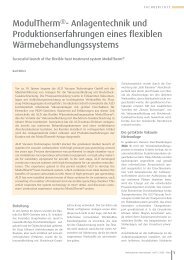

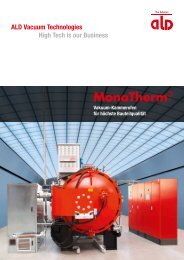


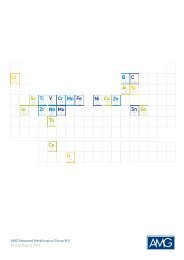
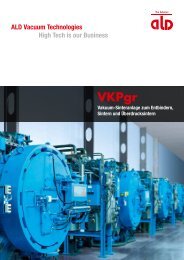

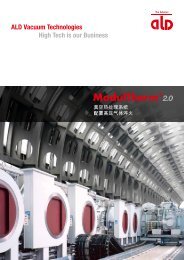
![TITANIUM brochure [PDF] - ALD Vacuum Technologies](https://img.yumpu.com/30889132/1/184x260/titanium-brochure-pdf-ald-vacuum-technologies.jpg?quality=85)

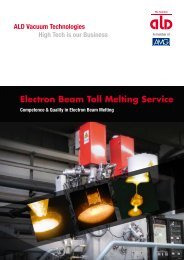
![(VID) Technology brochure [PDF] - ALD Vacuum Technologies](https://img.yumpu.com/30095121/1/184x260/vid-technology-brochure-pdf-ald-vacuum-technologies.jpg?quality=85)